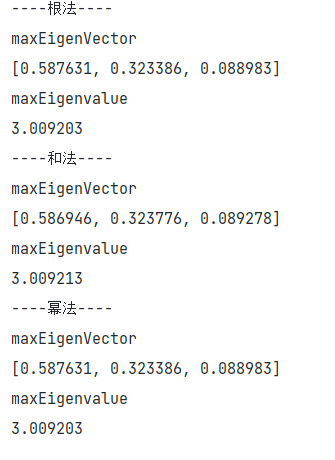正互反矩阵的最大特征值与特向求解-java
1、正互反矩阵
首先说一下什么是正互反矩阵,见下图,一看图其实就知道什么是正互反矩阵。
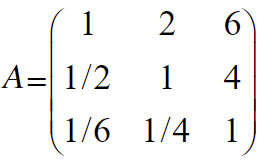
1.1 使用场景
当我们现在有一堆参数,分了好几个层次,每个层次里面又有好多参数,那么每个层次的每个参数权重如何设定,这时候,会用到这种类型的矩阵。为方便理解,可以将矩阵A看成下面的表格
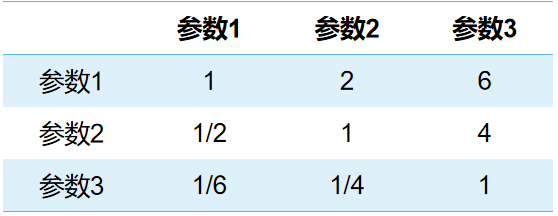
- 对角线元素:自己和自己相比,同等重要,所以都为1
- A[0][1]:参数2比参数1重要,所以是2(或其他的数字,这是有标准的)
- A[0][2]:参数3和参数1相比,参数3重要,同时也比参数2重要,所以参数3的重要程度取值至少要比A[0][1]的值大
至于比较两个参数之间的重要程度的取值,自行寻找标准。下面是标准之一:1-9标度法
| 相对重要性 | 定义 | 说明 |
|---|---|---|
| 1 | 同等重要 | 两个目标同样重要 |
| 3 | 略微重要 | 经验或判断,认为一个目标比另一个略微重要 |
| 5 | 相当重要 | 经验或判断,认为一个目标比另一个重要 |
| 7 | 明显重要 | 深感一个目标比另一个重要,并且这种重要性已经有实践证明 |
| 9 | 绝对重要 | 强烈的感到一个目标比另一个重要的多 |
| 2,4,6,8 | 两个相邻判断的中间值 | 折中时采用 |
1.2 矩阵计算
https://wenku.baidu.com/view/d70e0c746cdb6f1aff00bed5b9f3f90f76c64df3.html
可以使用平常手算时的那种计算方式,通过|λE-A| = 0得到特征值,再代入(λE-A)中求解该特征值的特征向量。其中,我们只用到最大特征值、及其特向。
这种算法很精确,但是很麻烦,(如果你要是用Matlab当我没说。。。),由于参数之间的重要程度关系,都是由经验判断,主观性很强,所以对精度要求其实不高,大概即可,故有三种快速计算最大特征值及其特向的方法:根法、和法、幂法
2 计算
三个方法公共的代码
/**
* 计算方阵的最大特征根及其特征向量
*
* @author silverbeats
* @date 2021/8/13 013 20:26
*/
public class MatrixUtil {
// 保留小数的位数
private final int BIT = 6;
/**
* 矩阵乘法
*
* @param a 矩阵a
* @param b 矩阵b
*/
public double[][] matrixMult(double[][] a, double[][] b) {
int arows = a.length,
acols = a[0].length,
brows = b.length,
bcols = b[0].length;
// 判断两个矩阵是否能够进行相乘
if (acols != brows) {
throw new RuntimeException("矩阵a的列数与矩阵b的行数不等,无法进行矩阵相乘");
}
// 保存矩阵相乘的结果
double[][] res = new double[arows][bcols];
for (int i = 0; i < bcols; ++i) {
// j,k 定位行乘列
for (int j = 0; j < arows; ++j) {
double sum = 0.0;
for (int k = 0; k < acols; ++k) {
sum += a[j][k] * b[k][i];
}
res[j][i] = sum;
}
}
return res;
}
/**
* 矩阵的列进行归一化,某元素在其所在列的比例
*
* @param matrix
*/
public void normalizedColumn(double[][] matrix) {
int rows = matrix.length,
cols = matrix[0].length,
row, col;
// 求出矩阵每一列之和
double[] temp = new double[cols];
for (col = 0; col < cols; ++col) {
for (row = 0; row < rows; ++row) {
temp[col] += matrix[row][col];
}
}
// 对matrix进行处理,得出每个元素在其所在列的占比
for (row = 0; row < rows; ++row) {
for (col = 0; col < cols; ++col) {
matrix[row][col] /= temp[col];
}
}
}
/**
* 合并矩阵的列,将m x n的矩阵变为m x 1的矩阵
*
* @param matrix
*/
public double[][] mergeColumn(double[][] matrix) {
int rows = matrix.length, cols = matrix[0].length;
double[][] res = new double[rows][1];
for (int row = 0; row < rows; ++row) {
double sum = 0.0;
for (int col = 0; col < cols; ++col) {
sum += matrix[row][col];
}
res[row][0] = sum;
}
return res;
}
/**
* 合并矩阵的行,将m x n矩阵变为1 x n矩阵
*
* @param matrix
*/
public double[][] mergeRow(double[][] matrix) {
int rows = matrix.length, cols = matrix[0].length;
double[][] res = new double[1][cols];
for (int col = 0; col < cols; ++col) {
for (int row = 0; row < rows; ++row) {
res[0][col] += matrix[row][col];
}
}
return res;
}
/**
* 保留指定个数的小数
*
* @param number 数字
*/
public double toFixed(double number) {
double temp = Math.pow(10, BIT);
return Math.round(number * temp) / temp;
}
/**
* arr是一维的最大特征向量,
* 由于最大特征向量是一个n x 1的二维矩阵,会转换为一维数组
* 易知特向的每一个元素以及最大特征根是double类型,会对其保留BIT位的小数
* 存在四舍五入后,最大特征根的特向元素之和不为1的情况,可能会多或少Math.pow(10, -BIT)
* 这里做的处理:将这个误差给到权重最小的参数身上,保证所有参数的权重和为1
*
* @param arr
*/
public void correction(double[] arr) {
int length = arr.length;
double bei = Math.pow(10, BIT);
double sum = 0.0;
for (double v : arr) {
sum = sum + v * bei;
}
// 四舍五入后没问题
if (sum == bei) return;
// 误差
double err = sum - bei;
// 定位到权重最小值的参数位置
int minRow = 0;
for (int i = 1; i < length; ++i) {
if (arr[i] < arr[minRow]) {
minRow = i;
}
}
arr[minRow] -= err / bei;
}
/**
* 二维数组转一维数组
*
* @param matrix
*/
public double[] convertData(double[][] matrix) {
int rows = matrix.length, cols = matrix[0].length;
int arrLen = rows * cols;
double[] res = new double[arrLen];
int index = 0;
for (int row = 0; row < rows; ++row) {
for (int col = 0; col < cols; ++col) {
res[index++] = matrix[row][col];
}
}
return res;
}
}
2.1 根法
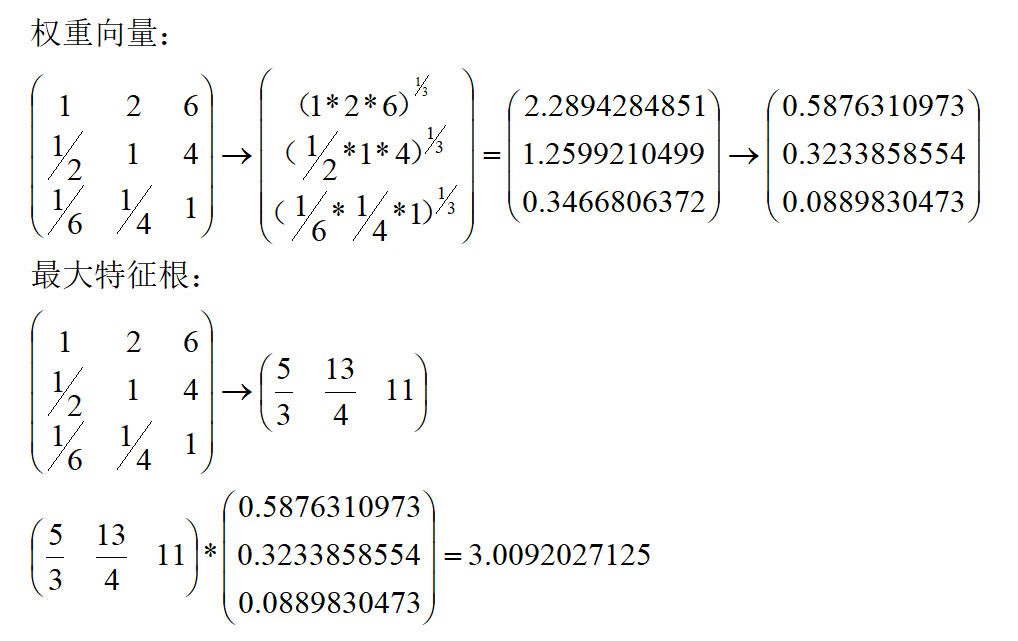
/**
* 计算方阵的最大特征根及其特征向量
*
* @author silverbeats
* @date 2021/8/13 013 20:26
*/
public class MatrixUtil {
/**
* 根法求解矩阵matrix最大特征根、及其特征向量
*
* @param matrix
*/
public Map<String, Object> rootMethod(double[][] matrix) {
if (matrix.length != matrix[0].length) {
throw new RuntimeException("必须是方阵");
}
// 保存结果用的
Map<String, Object> resultMap = new HashMap<>();
final int DIM = matrix.length;
// 1、计算权重向量(最大特征根的特向)
// 1.1 矩阵有DIM行,同行的元素进行相乘,之后再开DIM根号,得到DIM x 1矩阵
double[][] w = new double[DIM][1];
for (int row = 0; row < DIM; ++row) {
double mult = 1.0;
for (int col = 0; col < DIM; ++col) {
mult *= matrix[row][col];
}
w[row][0] = Math.pow(mult, 1.0 / DIM);
}
// 1.2 将w矩阵进行归一化,得到的就是权重向量
normalizedColumn(w);
// 2、计算最大特征根
// 2.1 将matrix按行进行合并相加
double[][] s = mergeRow(matrix);
// 2.2 s x w 的结果即为最大特征值,s是1 x DIM矩阵,w是DIM x 1矩阵,得到1 x 1矩阵
double maxEigenvalue = matrixMult(s,w)[0][0];
// 3、可选:将DIM x 1矩阵转一维,对数据进行小数保留,以及保留后权重和不为1的处理
double[] maxEigenVector = convertData(w);
for (int i = 0; i < maxEigenVector.length; i++) {
maxEigenVector[i] = toFixed(maxEigenVector[i]);
}
// 4、易知权重和为1,然而在经过小数保留后,可能会导致权重和不为1,进行处理
correction(maxEigenVector);
// --------------------------------------------------
resultMap.put("maxEigenvalue", toFixed(maxEigenvalue));
resultMap.put("maxEigenVector", maxEigenVector);
return resultMap;
}
}
2.2 和法

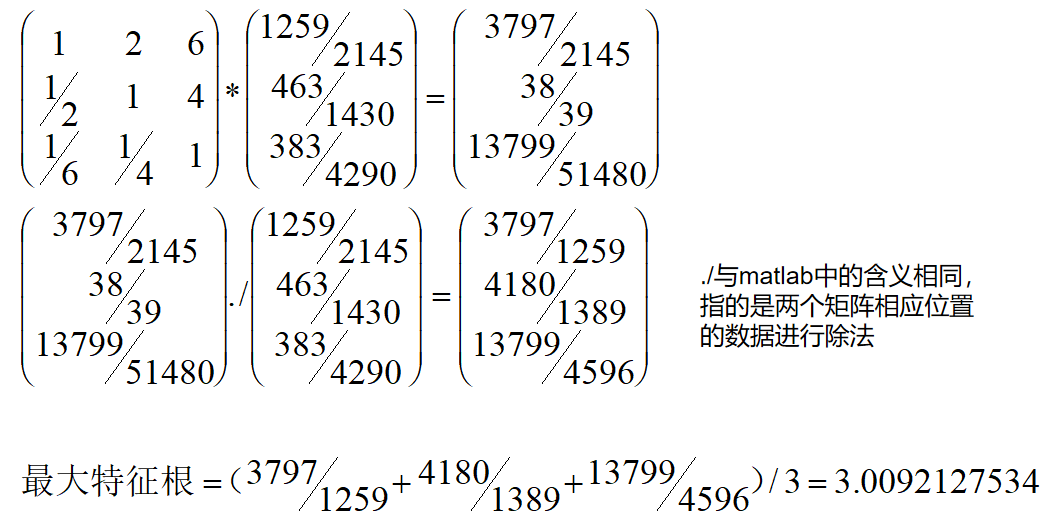
public class MatrixUtil {
/**
* 和法求解矩阵matrix的最大特征根、及其特征向量
*
* @param matrix
*/
public Map<String, Object> sumMethod(double[][] matrix) {
if (matrix.length != matrix[0].length) {
throw new RuntimeException("必须是方阵");
}
Map<String, Object> resultMap = new HashMap<>();
final int DIM = matrix.length;
// 判断矩阵w,拷贝一份matrix,目前与matrix一致,后面会对w进行修改
double[][] w = new double[DIM][DIM];
for (int row = 0; row < DIM; ++row) {
for (int col = 0; col < DIM; ++col) {
w[row][col] = matrix[row][col];
}
}
// 1、权重向量(最大特征根的特向)
// 1.1 将矩阵的每一列进行归一化处理,得到判断矩阵w
normalizedColumn(w);
// 1.2 判断矩阵w的所有列进行相加,变成n x 1的矩阵后进行归一化处理
// 此时得到的n x 1矩阵就是matrix最大特征根的特征向量
double[][] t = mergeColumn(w);
normalizedColumn(t);
// 2、计算最大特征根
// 2.1 将原矩阵matrix(m x m)与最大特向t(m x 1)进行矩阵乘法(m x 1)
double[][] mx = matrixMult(matrix, t);
// 2.2 将mx和maxEigenVector这两个m x 1的列矩阵对应位置进行相除
for (int row = 0; row < DIM; ++row) {
mx[row][0] /= t[row][0];
}
// 2.3 将mx这一列矩阵的所有元素求和,最后取个均值就是最大特征根
double maxEigenValue = 0.0;
for (int row = 0; row < DIM; ++row) {
maxEigenValue += mx[row][0];
}
maxEigenValue /= DIM;
// 3、可选:对数据进行小数保留,以及保留后权重和不为1的处理
double[] maxEigenVector = convertData(t);
for (int i = 0; i < maxEigenVector.length; i++) {
maxEigenVector[i] = toFixed(maxEigenVector[i]);
}
correction(maxEigenVector);
// --------------------------------------------------
resultMap.put("maxEigenvalue", toFixed(maxEigenValue));
resultMap.put("maxEigenVector", maxEigenVector);
return resultMap;
}
}
2.3 幂法
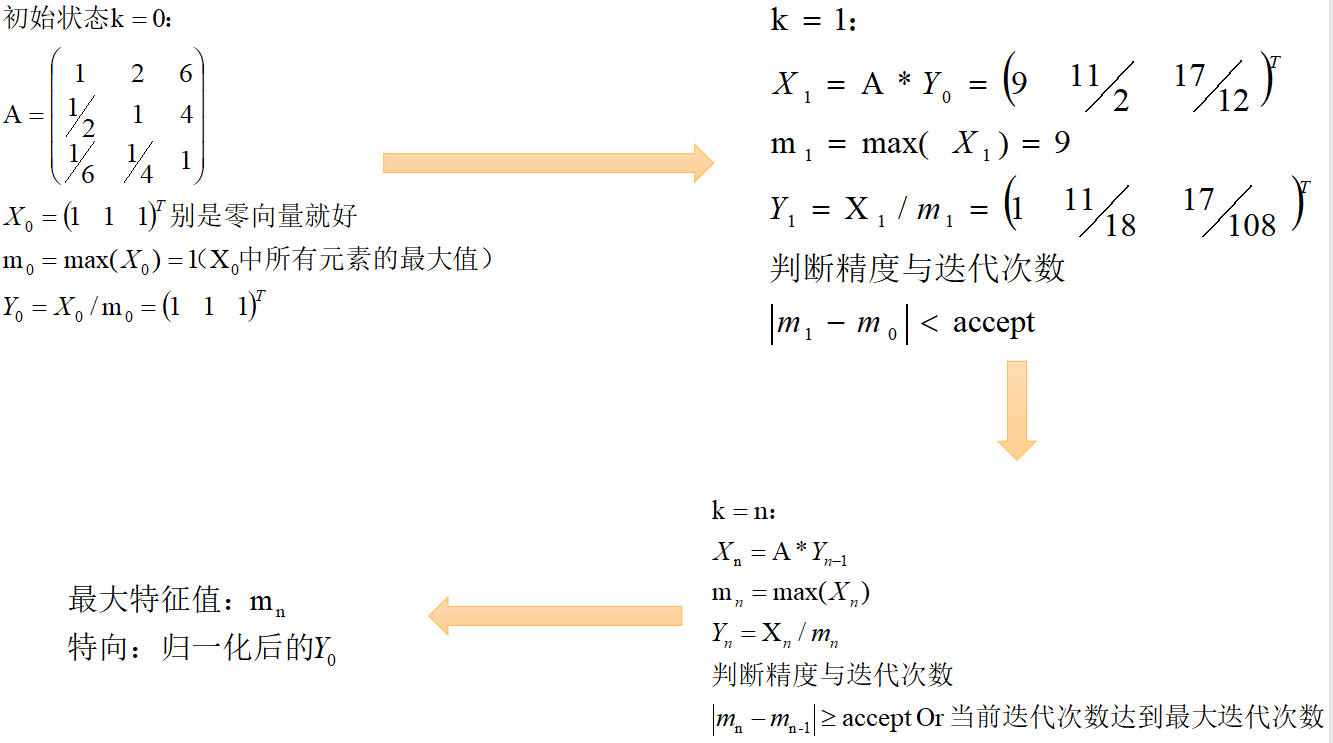
public class MatrixUtil {
/**
* 幂法
*
* @param matrix 矩阵
* @param times 最大迭代次数
* @param accept 可接受的误差
*/
public Map<String, Object> powMethod(double[][] matrix, int times, double accept) {
final int DIM = matrix.length;
// 1、初始化
// 1.1 初始正列向量Xk,用来迭代(k代表是第几次迭代)
// 1.2 初始化mk(mk是Xk这个列向量中最大的值)和yk(Xk/mk)
double mk = 1.0;
double[][] Xk = new double[DIM][1];
double[][] yk = new double[DIM][1];
for (int i = 0; i < DIM; ++i) {
yk[i][0] = Xk[i][0] = 1.0;
}
// 2、迭代计算
int cnt = 0;
while(true) {
double oldMk = mk;
// 2.1 迭代Xk
Xk = matrixMult(matrix, yk);
// 2.2 更新mk
mk = Xk[0][0];
for (int i = 1; i < DIM; ++i) {
if(Xk[i][0] > mk)
mk = Xk[i][0];
}
// 2.3 迭代yk
for (int i = 1; i < DIM; ++i) {
yk[i][0] = Xk[i][0] / mk;
}
++cnt;
// 2.4 精度检查,accept是可接受的精度误差
// 2.5 迭代次数检查,times是最大迭代次数
if(Math.abs(mk - oldMk) < accept || cnt >= times)
break;
}
// 3、求最大特征值,以及特向
// 3.1 最大特征值: 即mk
// 3.2 特向:对yk进行归一化后即为所求
normalizedColumn(yk);
// 4、可选:对mk和yk进行小数取舍
double[] maxEigenVector = convertData(yk);
for(int i = 0; i < DIM; ++i) {
maxEigenVector[i] = toFixed(maxEigenVector[i]);
}
correction(maxEigenVector);
// ---------------------------------------------
Map<String, Object> resultMap = new HashMap<>();
resultMap.put("maxEigenvalue", toFixed(mk));
resultMap.put("maxEigenVector", maxEigenVector);
return resultMap;
}
}
2.4 测试
public static void main(String[] args) {
double[][] arr = {
{1, 2, 6},
{0.5, 1, 4},
{1 / 6.0, 0.25, 1}
};
int maxTimes = 10000;
double accept = 1e-7;
MatrixUtil matrixUtil = new MatrixUtil();
Map<String, Object> rootMethodResultMap = matrixUtil.rootMethod(arr);
Map<String, Object> sumMethodResultMap = matrixUtil.sumMethod(arr);
Map<String, Object> powMethodResultMap = matrixUtil.powMethod(arr, maxTimes, accept);
System.out.println("----根法----");
rootMethodResultMap.forEach((k, v) -> {
System.out.println(k);
if (v instanceof double[])
System.out.println(Arrays.toString((double[]) v));
else
System.out.println(v);
});
System.out.println("----和法----");
sumMethodResultMap.forEach((k, v) -> {
System.out.println(k);
if (v instanceof double[])
System.out.println(Arrays.toString((double[]) v));
else
System.out.println(v);
});
System.out.println("----幂法----");
powMethodResultMap.forEach((k, v) -> {
System.out.println(k);
if (v instanceof double[])
System.out.println(Arrays.toString((double[]) v));
else
System.out.println(v);
});
}
